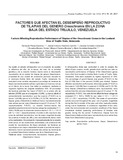Mostrar el registro sencillo del ítem
Factores que afectan el desempeño reproductivo de Tilapias del genero Oreochromis en la zona baja del Estado Trujillo, Venezuela
| dc.rights.license | http://creativecommons.org/licenses/by-nc-sa/3.0/ve/ | |
| dc.contributor.author | Perea G., Fernando P. | |
| dc.contributor.author | Perdomo Carrillo, Daniel Antonio | |
| dc.contributor.author | Corredor, Zenaida | |
| dc.contributor.author | Moreno Torres, Rosalba | |
| dc.contributor.author | Pereira Morales, Maryuri | |
| dc.contributor.author | González Estopiñán, Mario | |
| dc.date.accessioned | 2017-06-09T18:05:12Z | |
| dc.date.available | 2017-06-09T18:05:12Z | |
| dc.date.issued | 2017-03 | |
| dc.identifier.issn | 0798-2259 | |
| dc.identifier.uri | http://www.saber.ula.ve/handle/123456789/43494 | |
| dc.description.abstract | Se realizó un estudio retrospectivo con el propósito de analizar la influencia del año, de la época, del mes, de la variedad genética y de la relación hembra macho sobre el desempeño reproductivo de un plantel de tilapias del género Oreochromis, propiedad de una unidad de producción piscícola ubicada en el municipio Andrés Bello del estado Trujillo, Venezuela. Se consideró como variable respuesta el porcentaje de hembras de tilapia reproductivamente activas o grávidas (con huevos o larvas en el interior de la boca). Los datos se analizaron mediante la regresión logística del paquete estadístico SAS. El porcentaje de hembras grávidas fue mayor (P<0,01) en el primer año de estudio (25,5%) que en el segundo (13,9%). La época afectó el comportamiento reproductivo, que fue superior (P<0,01) en la época 1 (24,4%) que en la 2 (15,0%) y 3 (12,7%). Asimismo, las tilapias grises (Oreochromis niloticus) fueron reproductivamente más activas que las rojas (Oreochromis spp) (21,5 versus 17,1%, respectivamente; P<0,01). La relación hembra-macho fue estadísticamente similar entre las tres categorías analizadas (17,1; 19,6 y 16,9% para la relaciones hembra-macho = 1,5:1, > 1,5:1 = 2,0:1 y > 2,0:1, respectivamente). Durante el año ocurrieron dos picos de actividad reproductiva, uno de mayor magnitud durante los primeros 4 meses del año y otro marcadamente menor entre julio y septiembre. En conclusión, irrespectivamente de la relación entre sexos, en las condiciones ambientales y de producción del plantel de reproductores de tilapia estudiado, las hembras se reprodujeron con mayor intensidad durante el periodo de sequía. Asimismo, fueron reproductivamente más activas las hembras de la variedad Oreochromis niloticus que de la Oreochromis spp. | es_VE |
| dc.language.iso | es | es_VE |
| dc.publisher | SABER-ULA | es_VE |
| dc.rights | info:eu-repo/semantics/openAccess | |
| dc.subject | Comportamiento reproductivo | es_VE |
| dc.subject | Tilapias | es_VE |
| dc.subject | Género Oreochromis | es_VE |
| dc.subject | Trópico | es_VE |
| dc.title | Factores que afectan el desempeño reproductivo de Tilapias del genero Oreochromis en la zona baja del Estado Trujillo, Venezuela | es_VE |
| dc.title.alternative | Factors Affecting Reproductive Performance of Tilapias of the Oreochromis Genus in the Lowland Area of Trujillo State, Venezuela | es_VE |
| dc.type | info:eu-repo/semantics/article | |
| dc.description.abstract1 | A retrospective study was conducted in order to analyze the effect of year, season, month, genetic strain and the sex ratio on reproductive performance of tilapias of the Oreochromis genus from a fish farm located in Andrés Bello County of Trujillo State, Venezuela. Data were analyzed by logistic regression of SAS. The percentage of gravid tilapias was greater (P<0.01) in the first (21.5%) than in the second (13.9%) year studied. Season affected reproductive performance, which was greater (P<0.01) in the season 1 (24.4%) than in seasons 2 (15.0%) and 3 (12.7%). Grey tilapias (Oreochromis niloticus) were reproductively more actives than the red ones (Oreochromis spp) (21.5 versus 17.1%, respectively; P<0.01). Sex ratio did not affect the three categories analyzed (17.1, 19.6 y 16.9% for sex ratios = 1.5:1, > 1.5:1 = 2.0:1 y > 2.0:1, respectively; P>0.05). Two peaks of reproductive activity occurred throughout the year; one of greater magnitude during the first 4 months of the year and other markedly smaller during July to September. In conclusion, regardless of sex ratio, under the environmental and production conditions of the tilapia broodstock studied, spawning performance of females was greater during the dry period. Furthermore, tilapias from the Oreochromis niloticus strain were reproductively more active than those from Oreochromis spp group. | es_VE |
| dc.description.colacion | 78-87 | es_VE |
| dc.description.email | ferromi@ula.ve | es_VE |
| dc.description.email | dperdomocarrillo@gmail.com | es_VE |
| dc.identifier.depositolegal | pp199102ZU46 | |
| dc.identifier.edepositolegal | ppi201502ZU4665 | |
| dc.identifier.eissn | 2477-944X | |
| dc.publisher.pais | Venezuela | es_VE |
| dc.subject.institucion | Universidad del Zulia (LUZ) | es_VE |
| dc.subject.institucion | Universidad de Los Andes (ULA) | es_VE |
| dc.subject.keywords | Reproductive performance | es_VE |
| dc.subject.keywords | Tilapia | es_VE |
| dc.subject.keywords | Oreochromis genus | es_VE |
| dc.subject.keywords | Tropic | es_VE |
| dc.subject.publicacionelectronica | Revista Científica | |
| dc.subject.seccion | Revista Científica: Fauna Silvestre | es_VE |
| dc.subject.thematiccategory | Medio Ambiente | es_VE |
| dc.subject.tipo | Revistas | es_VE |
| dc.type.media | Texto | es_VE |
Ficheros en el ítem
Este ítem aparece en la(s) siguiente(s) colección(ones)
-
Revista Científica - 2017 - Vol.XXVII - No. 002
Marzo - Abril 2017


